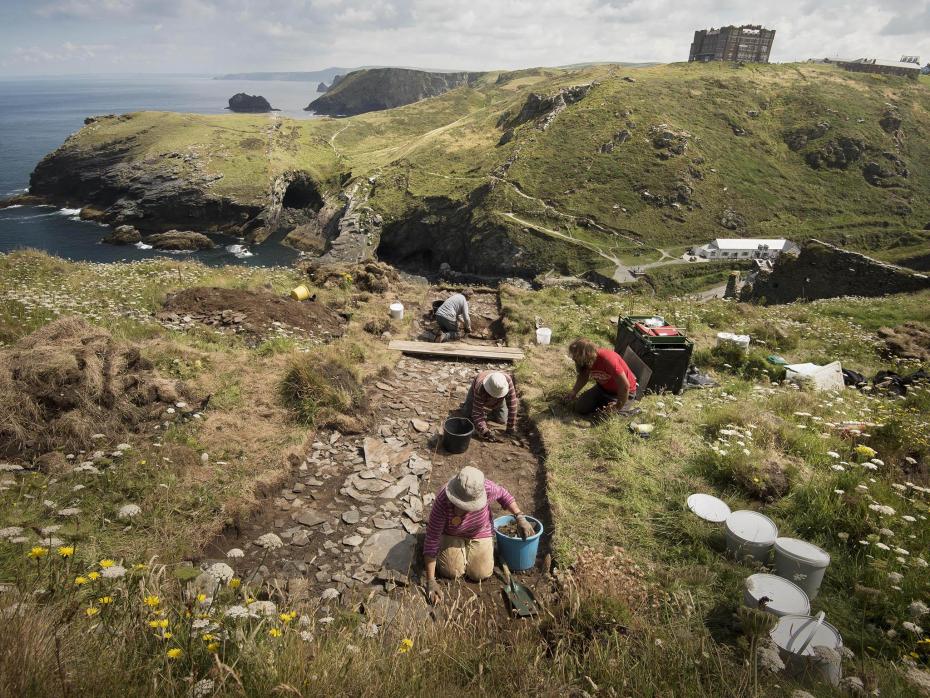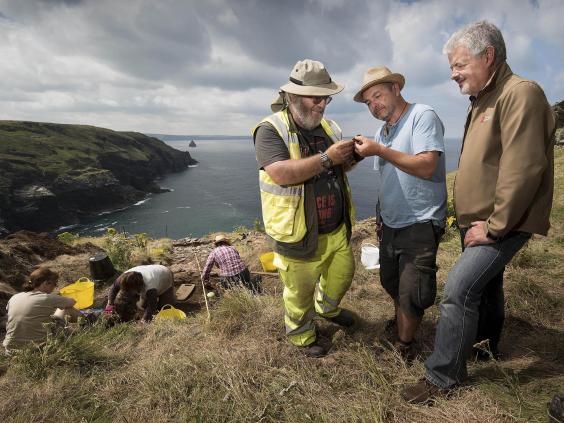“The discovery of high-status buildings – potentially a royal palace complex – at Tintagel is transforming our understanding of the site. It is helping to reveal an intriguing picture of what life was like in a place of such importance in the historically little-known centuries following the collapse of Roman administration in Britain.” – Win Scutt, Curator for English Heritage’s properties in Western England.

PHOTO: independent.co
CORNWALL, ENGLAND – Archaeologists have found an enormously significant Dark Ages castle that may be related to the legendary King Arthur.
It’s been the subject of popular debate among historians and scholars as to whether or not King Arthur was an actual person, or just a mythological character who existed as a fusion of several different historical figures. There really isn’t a lot of evidence of his existence. Most of what we know of King Arthur comes from the poem L’morte D’Arthur by Sir Thomas Mallory, and a work called Historia Regun Britanniae (The History of the Kings of Britain) by medieval Welsh historian, Geoffrey of Monmouth.
In the story of King Arthur as told by Geoffrey of Monmouth, Arthur was conceived in Tintagel, Cornwall. His father, Uther, had had an affair with the beautiful wife of a local ruler. As Geoffrey said, the whole thing transpired in an ancient fortress. One that, by Geoffrey’s time, had been long-since abandoned. Archaeologists and historians have no record of any such fortress. At least, they hadn’t until now.
Archaeologists working in Tintagel have stumbled across a fortress that may fit the bill. It’s a huge complex with walls that are one meter thick of strong, well-crafted masonry. It has carved steps and slate flagstone floors, and it dates to somewhere in the 5th and 6th centuries – about the time that Geoffrey’s King Arthur would have lived.
The other catch? This particular site at Tintagel looks to have been completely abandoned by the 7th and 8th centuries in England, probably due to a historic plague that was the precursor to the later Black Plague of the Middle Ages. It would have fallen into ruin by the time Geoffrey of Monmouth wrote about the legendary castle in Tintagel where King Arthur was conceived. Perhaps this was the very castle Geoffrey of Monmouth was writing about.
There’s no way to know for certain as of yet whether or not the castle is, for sure, connected to the legend of King Arthur and Camelot. However, connected or no, the site is still immensely important to the archaeological record of early post-Roman Britain.
Living in the Lap of Luxury

PHOTO: independent.co
Archaeologists have found a dozen or so separate buildings in the complex, most of which are extremely large for the time. Two of them are eleven meters long and four meters wide. This is, in fact, one of the only pieces of architecture that we have dating back to this period of British history, which makes it a very exciting find.
One thing is certain: the people who lived here were living on the top of ancient Britain’s society.
Among the artifacts at the site are pottery and glass shards in huge numbers…and not just any pottery and glass, either. This particular pottery belonged to western Turkey and the area around Tunisia. They were drinking expensive, imported wine and cooking with Greek olive oil. Even their dinnerware was the very best money could buy, shipped all the way from Turkey and North Africa. Their cups? Those were the finest painted glass cups from France.
The complex is sprawled over most of the Tintagel promontory. Experts think that it was more like a small city rather than a home. Artisans, soldiers, and other royal employees all lived and worked together.
Whoever the king who lived here was, he was definitely no small man. He was probably the king of Dumnonia, a post-Roman settlement that spawned from a Roman trade colony. Of course, for years, historians believed early Britain was isolated from the rest of the world in terms of trade and international dialogue, but this site is proving that assumption wrong.
It’s likely that this settlement was, at the very least, part of the Kingdom of Dumnonia. It was one of the few kingdoms not taken over by invading Anglo-Saxons. It remained under native British control, and that meant that it still had good ties with the Roman Empire.
Though the Roman Empire withdrew from Britain around 410, when barbarian tribes threatened their homeland’s borders, they must have set trade routes back up when Constantinople was established as the new capital of the Roman Empire. By 554, when this site at Tintagel was flourishing, Constantinople had recaptured much of Italy, North Africa, and Southern Spain, making trade between Dumnonia and Rome very possible.
![King Arthur's Statue at Tintagel [PHOTO: independent.co]](https://historythings.com/wp-content/uploads/2016/08/tintagel-king-arthur-02.jpg)
King Arthur’s Statue at Tintagel [PHOTO: independent.co]
We don’t know enough about whether or not King Arthur was an actual person or just a mish-mash of different mythological and historical figures to make a clear decision. However, what we can say is that someone extremely powerful and important lived there, and that someone was a native of Britain, and lived at the same time Geoffrey of Monmouth said King Arthur did, at a huge, luxurious castle that is very likely to be the self-same castle where Geoffrey of Monmouth said King Arthur was conceived.
So, again, is the site related to King Arthur?
We’ll let you decide.

